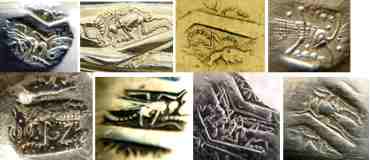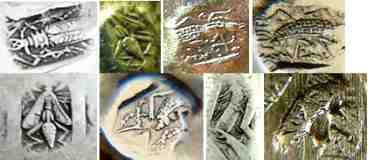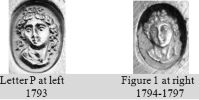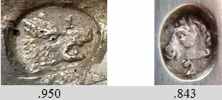by Robert
Massart
(click on photos to enlarge image)
FRENCH INVENTORY MARKS (POINÇONS DE RECENSE)
FROM 1722 TO 1984
INTRODUCTION
Everyone interested in antique silver knows that the French
system of marking silver articles is quite intricate and amongst
the many punches in use, a specific mark, the inventory or
census mark (poinçons de recense), is often a source of
misinterpretation.
This article develops the reasons for which the 'poinçons de
recense' were created, describes their history and provides an
illustrated description of them.
-------------
Fraud is of all time and, in order to counter it, the French
government always fought against it by introducing more
sophisticated defense systems. Particularly silversmithing did
not escape from fraud, theft of hallmarks, imitations and
forgery. In order to avert this, and because marks had been
counterfeited, the government, during the "Ancien Régime",
created in 1722 the inventory mark and organised the first free
census.
Since that date inventory means that, after a certain
date, all preceding marks lose their value and all articles
need new marks.
'Recenser' (inventorying or verification), means an official
counting of golden and silver articles before they are sold.

|
|
Inventory marks
for Paris during the "Ancien Régime"
|
In 1789 and later in 1791, the law Le Chapelier (see note 1),
banned guilds and organizations, and with them the control of
precious metals, corresponding marks and taxes. The production
of silver objects became archaic and, in absence of any control,
some silversmiths manufactured articles of inferior quality.

|
|
Isaac-René-Guy Le
Chapelier
|
Trying to find a solution for this situation, the Association of
Gold and Silversmiths decided to create two hallmarks "Greek
woman's head". Both marks however had no official value as
guarantee.
The 15 Vendémiaire year V (6 October 1795) the Counsel of Five
Hundred (see note 2) decided to express the fineness of
silver in thousands. Two marks were created: a boar's head for a
fineness of 950 thousands and a horse head for a fineness of 843
thousands.
1798 - 1809
On the initiative of the Directory (see note
3) the law of 19 Brumaire year VI (9 November 1797) created
the Guarantee Directory and replaced the Jurandes, the
communities and other corporations, by guarantee offices.
After the revolution, the government ordered that an inventory
mark should be added to all articles marked during the "Ancien
Régime".
Several inventories (recenses) followed each other, of which the
law of Brumaire was the first. This law stipulates: "The
inventory mark will be applied by the public authorities when it
is necessary to prevent the result of any misdoing of the
guarantee or other marks. Simultaneously with the new marks
which will be stamped, an inventory mark will be applied on
previous articles, certifying thereby the ratification of the
fineness and payment of the taxes. "
The same law clarifies: "The makers of false marks, and those
who use them, will be condemned to ten years of incarceration
and laid in irons, and their articles confiscated."
In the case of fraudulent use, theft or counterfeit of marks, a
verification was organised. Once the fraud recognised, all the
articles on the market were presented to the guarantee offices
and, after control of the marks, they were punched with the
inventory mark. The old mark traces ceased to be legal, after
which a new series of marks was established. The punching of the
inventory mark was free of charges when the articles were
legally marked and when the application was performed within the
prescribed delay defined by the law. Articles having other marks
or marks worn by use or polishing had to be presented to the
guarantee office, after which the silversmith had to pay the
taxes, otherwise the articles were destroyed.
|
Large articles -
Liberty head (Paris)
|
Large articles -
Liberty head (Departments)
|

|

|
|
The mark
represents a girl's head in profile with a
Phrygian (see note 4) cap, the look
facing right. The mark is surrounded by a
vertical oval outline.
An article with this mark guarantees a fineness
of at least 800/1000
|
The mark
represents a girl's head in profile with a
Phrygian cap, the look facing left.
An article with this mark guarantees a fineness
of at least 800/1000
|
|
Small articles -
Liberty head (Paris)
|
Small articles -
Liberty head (Departments)
|

|

|
|
The mark
represents a girl's head in profile with a
Phrygian cap, the look facing left. The mark is
surrounded by a vertical oval outline
An article with this mark guarantees a fineness
of at least 800/1000
|
The
mark represents a girl's head in profile with a
Phrygian cap, the look facing right
An article with this mark guarantees a fineness of
at least 800/1000
|
1809 - 1819
The second general (see note 5) inventory occurred on 7
July 1809. This law declares: "the new guarantee hallmarks
for articles manufactured in gold or silver, enforced by decree
of the imperial law of 11 Prairial year II (30 May 1794), will
exclusively be handled by the guarantee offices, starting 1
September 1809".
|
Large articles -
Cérès head (Paris)
|
Large articles -
Head of Mercury (Departments)
|

|

|
|
Cérès, in profile
the look facing left.
Roman goddess of
agriculture, harvests and fecundity.
The mark is surrounded by a vertical oval
outline.
An article with this mark guarantees a fineness
of at least 800/1000
|
Head of Mercury
in profile, wearing a winged helmet.
Roman god of commerce, travel and messenger of
the other gods
The mark is surrounded by a triangular shape
with curved corners
An article with this mark guarantees a fineness
of at least 800/1000
|
|
Medium articles -
Right ear (Paris)
|
Medium articles -
Eagle's head (Departments)
|

|

|
|
A right ear
An article with this mark guarantees a fineness
of at least 800/1000
|
Eagle's head,
with open beak, in profile, with the look facing
left
An article with this mark guarantees a fineness
of at least 800/1000
|
|
Small articles -
Right hand pointing left (Paris)
|
Small articles -
Eye (Departments)
|

|

|
|
Right hand, in
profile, with the fingers pointing to the left.
An article with this mark guarantees a fineness
of at least 800/1000
|
An eye in profile,
with the look facing right. An article with this
mark guarantees a fineness of at least 800/1000
|
1819 - 1838
A third general inventory became effective by Royal ordinances
of 22 October 1817 and 1 July 1818 and the different hallmarks
remained in use from 16 August till 9 May 1838. This inventory
introduced a new mark, the bigorne or countermark.
|
Large Bigorne
(Paris) Large Bigorne (Departments)
|

|
.
|
|
Medium Bigorne
(Paris) Medium Bigorne (Departments)
|
|
Less insects as for the large bigorne, but
identical for Paris and Departments
|
|
Small Bigorne
(Paris)
|
Small Bigorne
(Paris and Departments)
|
Small Bigorne (Departments)
|

|

|

|
|
Triangles and
lozenges with linear designs and letters
|
16 August 1819 - 16 November 1819
|
Large articles -
Fleur de lys (Paris)
|
Large articles -
Greyhound (Departments)
|

|

|
|
Fleur de lys
surrounded by a vertical oval outline
|
Greyhound with
the look facing right, surrounded by a
horizontal oval outline. A different symbol for
each city
|
|
Small articles -
Chickweed flower (Paris)
|
Small articles -
different hallmarks (Divisions)
|

|

|
|
Chickweed flower
|
The departments
are grouped in divisions
North: Coffee pot / North-East: Tower / East:
Chalice / South-East: Beaker / South: Bell /
South-West: Watering-can / West: Vessel /
North-West: Guitar / Center: Book
|
1822 - 1838
Due to the discovery in many French cities of a great number of
articles with false marks (primarily on foreign watches), an
ordinance of 19 September 1821 created special marks for the
clock and watch industry, and ordered a fourth partial (see
note 6) inventory which remained applicable until 1 May
1822.
The crayfish mark remained applicable until 9 May 1838 to
guarantee fineness.
|
Clocks and
watches - Crayfish (Paris)
|
Clocks and
watches - Crayfish (Department)
|

|

|
|
Crayfish facing
left with a 'différent' for each assay office
under it (P for Paris and a number for the
departments, e.g. '23' for Montbéliard assay
office), surrounded by a horizontal oval outline,
|
1838
By ordinances of 30 June 1835 and 7 April 1838, the inventory
marks are the giraffe head for large articles and the bulldog
head for small articles. The design of the marks is identical
for Paris and the departments apart from the specific symbol for
each assay office, named 'différent'.
|
Large articles -
Giraffe head (Paris)
|
Large articles -
Giraffe head (Departments)
|

|

|
|
Small articles -
Bulldog head (Paris)
|
Small articles -
Bulldog head (Departments)
|

|

|
1838 - 1984
A fifth general inventory of 7 April 1838 introduced several
modifications, such as new more complex bigornes and replacement
of the totality of hallmarks. The law clarifies: "The
fineness and the guarantee office mark are replaced by one
unique mark which will bear a particular symbol for each
office." This particular symbol is named 'a différent' and
the unique hallmark 'Minerve'.
|
Bigorne (Paris)
|
Bigorne (Departments)
|

|

|
|
Countermark at
the reverse of the guarantee mark - Insects are
represented in profile for Paris and in bird's
eye view for the departments
|
APPENDIXES
-
Ordinances of the King
-
Tableau des poinçons dont l'emploi est prescrit par l'ordonnance
du 7 avril 1838 (Table of marks whose application is
prescribed by the ordinance of 7 April 1838)
ENDNOTES
note 1: Isaac-René-Guy Le Chapelier was a French
politician, born 12 June 1754 at Rennes, and beheaded by the
guillotine in Paris on 22 April 1794.
note 2: The Council of Five Hundred was the lower house
of the legislature of France during the period known as
Directory, from 22 August 1795 until 9 November 1799.
note 3: The Directory (French: Directoire) was the
government of France operating from 22 November 1795 until 9
November 1799 and overthrown by Napoleon in 1799.
note 4: A Phrygian cap, sometimes called liberty cap, is
a soft conical cap with the top pulled forward. In artistic
representations it signifies freedom and the pursuit of liberty.
note 5: General inventory: control of all the articles
before they are sold.
note 6: Partial inventory: limited to one category of
articles.
BIBLIOGRAPHY
- International Hallmarks on Silver collected by Tardy - 2005
reprint
- Dictionnaire des poinçons de fabricants d'ouvrages d'or et d'argent,
Paris 1838-1875 - Catherine Arminjon, James Beaupuis, Michèle
Bilimoff - 1994
- Poinçons des ouvrages d'or et d'argent, Lyon 1798-1940 -
Maryannick Chalabi, Marie-Reine Jazé-Charvolin - 1993
-
L'argent massif en France et le poinçon de bigorne - Robert
Massart - 2011
- Recueil critique de jurisprudence et de législation, M. Dalloz
- 1838
|
|






























